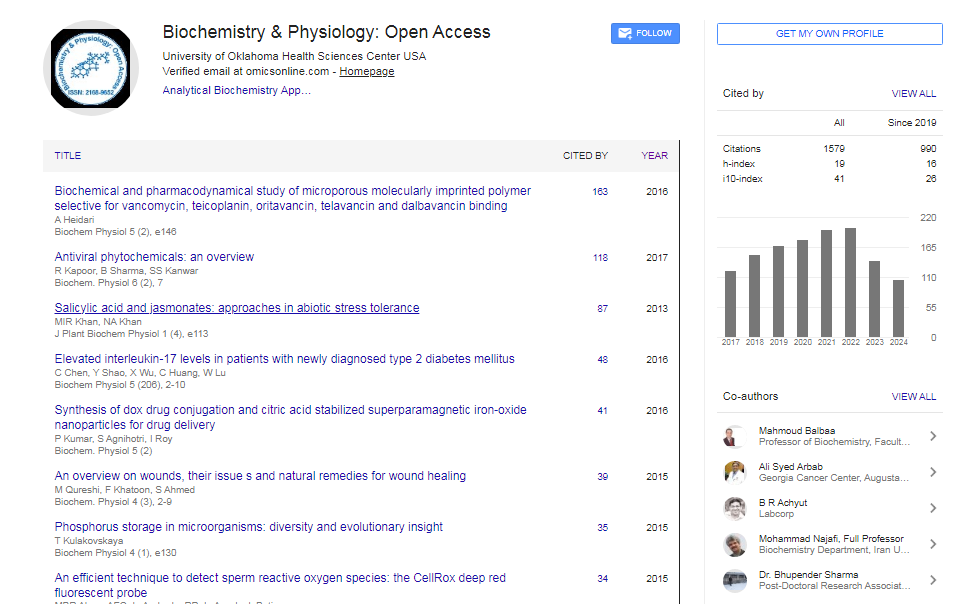Research Article
Physiological Parameters of Clinical Yeasts Growth and Isolation of Specific Antigens
| Arzumanyan Vera1*, Shmeleva Olga1, Serdiuk Olga2 and Michailova Natalia1 | |
| 1Mechnikov Research Institute for Vaccines and Sera, Moscow, Russia | |
| 2Institute for Diagnostics and Prophylaxis of Social Diseases, Moscow, Russia | |
| *Corresponding Author : | Vera Arzumanyan Mechnikov Research Institute for Vaccines and Sera. Moscow, Russia Tel: 8-916-495-20-21 Fax: 8-495-917-49-00 E-mail: veraar@mail.ru |
| Received July 29, 2013; Accepted August 22, 2013; Published August 26, 2013 | |
| Citation: Arzumanyan V, Shmeleva O, Serdiyk O, Michailova N (2013) Physiological Parameters of Clinical Yeasts Growth and Isolation of Specific Antigens. Biochem Physiol 2:116. doi:10.4172/2168-9652.1000116 | |
| Copyright: © 2013 Arzumanyan V, et al. This is an open-access article distributed under the terms of the Creative Commons Attribution License, which permits unrestricted use, distribution, and reproduction in any medium, provided the original author and source are credited. | |
Abstract
At present time 7 genera of clinically important yeasts are known - Candida, Malassezia, Saccharomyces, Cryptococcus, Trichosporon, Geotrichum and Rhodotorula. Most of them can cause deep and superficial mycoses, but some are associated with allergic diseases. Development of diagnostic preparations from yeast Candida was started many years ago and is constantly improving. Commercial kits with antigens of yeast Malassezia has appeared recently. The known methods of antigens extraction based on the disruption of yeasts cells (mechanic or ultrasonic). This approach coupled with the presence of cross reactive determinants exists in many fungi. Aim of this work was to develop the specific antigenic preparations from all listed yeast genera. We have used the following yeast strains from our institute collection - Candida albicans № 927, Geotrichum candidum № 1206, Malassezia furfur № 1451, Rhodotorula mucilaginosa № 132, Cryptococcus neoformans № 3465, Trichosporon cutaneum № 18; and Saccharomyces cerevisiae Y-375 (Russian Collection, Pushchino). Yeasts were cultured in liquid defined media up to the end of exponential growth phase; maximal growth rate and doubling time were calculated. After that cultures were centrifuged, and supernatants were lyophilized, and cells were used for mice immunization and antigen extraction. White mice were immunized with cell suspension for 5 times with increasing doses (interval 1 week), after that sera were obtained. Antigen preparations № 1 were obtained from cells by rapid extraction with sodium dodecyl sulfate solution – in this case cell walls were not disrupted, and extract consisted in general from superficial proteins. Preparations № 2 are lyophilized supernatants (see above). To estimate preparation specificity dot-blot analysis of each preparation with each mouse serum was carried out. From this analysis it was demonstrated that all preparations № 1 contained the specific antigens, i.e. each preparation reacted with better extent with corresponded serum. However in some extent all these preparations were polluted with cross-reactive proteins (spots with other sera). Moreover the preparation from Malassezia furfur reacted with control sera, maybe because of this yeast is the resident of healthy animal skin. At the same time preparations № 2 were free from cross-reactive proteins, except preparation from Malassezia furfur – no one sera, included control sera (pure mouse) reacted with this preparation. We can come to conclusion, that in the case of Malassezia one should carry out special purification of culture liquid, but in the case of other yeasts cells free culture supernatants are preferable for creating of antigen diagnostic kits.

 Spanish
Spanish  Chinese
Chinese  Russian
Russian  German
German  French
French  Japanese
Japanese  Portuguese
Portuguese  Hindi
Hindi 